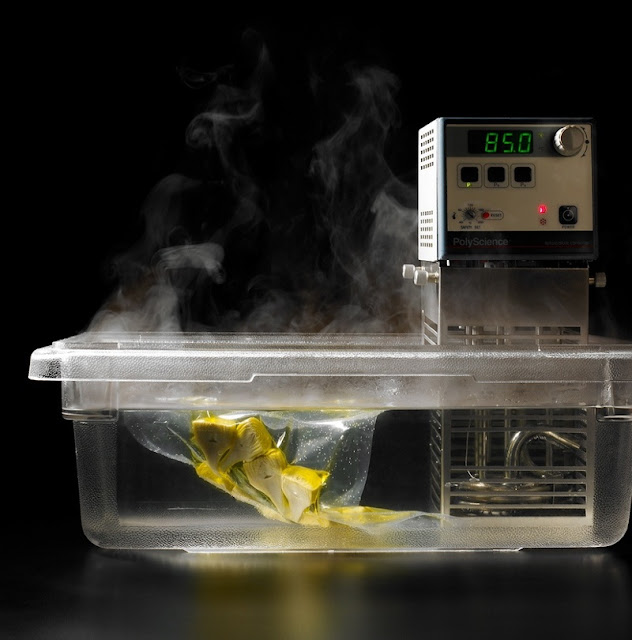MOLECULAR GASTRONOMY: Cooking with Liquid Nitrogen, Vacuum Machines and Syringes (Part 5)
 |
| source: foodslashscience |
The recipe for liquid olives, which calls for 1.25 grams (0.04 ounces) of calcium chloride, 200 grams (7 ounces) of green olive juice, 2.5 grams (0.09 ounces) of alginate and 500 grams (18 ounces) of water, sounds more like the materials list of a high school chemistry experiment and hints at one important piece of equipment every molecular gastronomist must have: a scale. A good digital scale is indispensable and can even be used for nonculinary tasks, such as evaluating nutritional content or even calculating postage.
Here are some other tools you might need to master molecular gastronomy:
- Vacuum machine. Remember the sous vide steak we talked about last section? If you really want to do the job right, consider a vacuum sealer. A good model will evacuate the air from plastic bags and then seal the bag tightly closed. You can also buy a thermal bath to provide precise heating of your water bath.
- Hypodermic syringe. You may shudder at the sight of a needle, but you may have to overcome your fear if you want to practice molecular gastronomy. As we've already seen, syringes are helpful in the process of spherification. Some chefs also use them to inject liquids into meat to enhance flavor and texture.
- Liquid nitrogen. At a temperature of -321 degrees F (-196 degrees C), liquid nitrogen will flash freeze any food it touches. As it boils away, it gives off a dense nitrogen fog that can add atmosphere and drama to food preparation. Unfortunately, liquid nitrogen must be transported in specially made flasks and can be dangerous if it touches skin. A safer alternative is the Anti-Griddle, described next.
- Anti-Griddle. The Anti-Griddle, a product of PolyScience, looks like a traditional cooktop, but it doesn't heat up food. Its -30 degrees F (-34 degrees C) surface instantly freezes sauces and purées or freezes just the outer surfaces of a dish while maintaining a creamy center.
- The Gastrovac. Manufactured by International Cooking Concepts, the Gastrovac is three tools in one: a Crock-pot, a vacuum pump and a heating plate. In its low-pressure, oxygen-free atmosphere, the Gastrovac cooks food faster at lower temperatures, which helps the food maintain its texture, color and nutrients. When the food is done warming, you restore the pressure and create what ICC calls the "sponge effect." The liquid rushes back into the food, bringing intense flavors with it.
Now we're ready to put everything together. In the next section, we'll present three recipes for a molecular gastronomy-inspired meal.
Source:
science.howstuffworks.com

Comments
Post a Comment